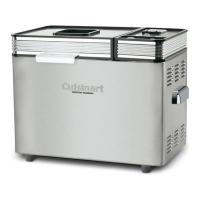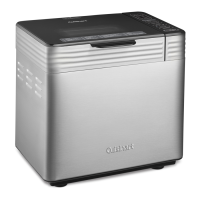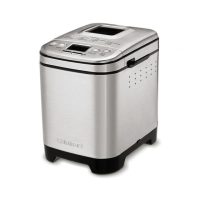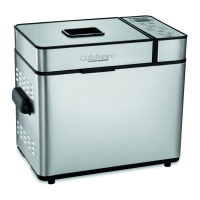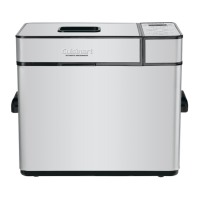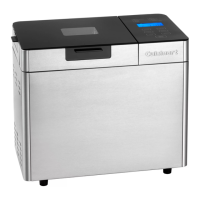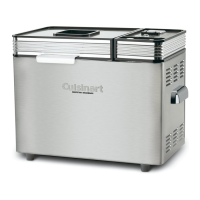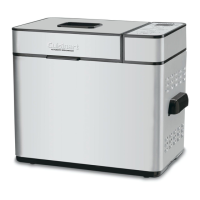17
ERROR CODES
HHH or EEE
with continuous beeps:
Please contact your nearby service center.
E00 or E01 (with 3 beeps when started):
E00 indicates ambient temperature is too low [-4°F (-20°C)] to bake
bread.
E01 indicates the temperature of the bread maker is too high to
bake bread. This usually occurs when trying to make two succes-
sive loaves. The unit should cool from baking cycle before starting to
knead a new loaf. Let the unit cool for 10 minutes prior to starting a
new loaf.
BREAD MAKER PANTRY
To be able to prepare breads quickly and easily in your Cuisinart™
Convection Bread Machine, we suggest keeping some basics on
hand. Depending on the types of breads you and your family prefer,
you may also want to have some of the other items readily available.
Not all the ingredients listed are in the recipes, but can be added to
improve taste and texture.
All-Purpose Flour –
Can be bleached or unbleached – we prefer
unbleached. For the bread machine, all-purpose our would be used
for the Quick Breads (also referred to as batter breads in some cook-
books). Can also be used to make yeast breads, but bread our with
its higher protein and gluten levels will give you better results.
Ascorbic Acid (Vitamin C)
– Acts as a preservative, deterring mold
and bacteria growth. Adding a little ascorbic acid to Artisan Breads
(Doughs) will enable the yeast to work longer, producing a more
avourful, well-textured bread. Professional bakers often add it to
French breads, boules, and baguettes when preparing the dough.
A crushed (powdered) vitamin C tablet may be used. Use about
1
⁄8
teaspoon (0.5 ml) per 3 cups (750 ml) our.
Bread Flour –
An unbleached our high in protein and gluten. This is
the most basic our for the bread machine and should be used rather
than unbleached all-purpose our for yeast breads.
Cake Flour –
A very soft our with low protein. Do not use cake our
for yeast breads unless a recipe specically requires it. It is most often
used to make very tender cakes and pastries.
Dry Milk –
(fat-free or regular) When loading ingredients add pow-
dered milk along with our. Using dry milk instead of fresh milk
enables you to use the Delay feature. Dry milk is also added to breads
(often along with fresh milk/milk products) to increase nutritional
value.
Eggs – Add taste, richness and colour to breads. They act as emulsi-
ers and aid in keeping breads fresh and moist. Do not ever use with
Delay Feature unless using powdered egg or powdered egg white
and adding with our. Egg washes (egg beaten with water or milk)
are used with some Dough Only recipes to brush on shaped dough
after rising, before baking, to add colour and shine to nished baked
goods.
Fats (assorted) –
(unsalted butter, olive oil, vegetable oil) – Add taste,
texture and moisture to breads. Most French breads do not have
added fats. We suggest using unsalted butter or a good quality olive
oil for recipes calling for butter or olive oil.
Garlic –
In small amounts, garlic aids development of the yeast – but
too much garlic will cause the yeast and bread structure to collapse.
Ginger (powdered) –
Boosts yeast activity and keeps it working lon-
ger. Also aids in keeping breads fresh. Use about ¼ teaspoon (1 ml)
per 3 cups (750 ml) our – this small amount will not affect avour.
Lecithin – May be added to bread to maintain freshness and mois-
ture. It also works with gluten to produce a lighter bread. It is derived
from either soy or egg yolks and comes in either liquid or granular
form.
Non-Diastatic Malt –
This gives breads better structure, and can
make them softer, more tender and give them a longer shelf life. Add
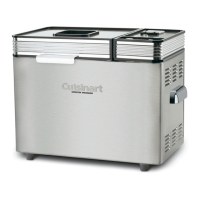
